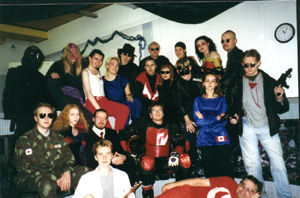Colors Explained
Part Eight: Aftermath
Colors was a huge success nearly every player loved it, and despite
my best intentions, it turned into something of a semi-regular tabletop
RPG campaign. A sequel (of sorts) was also played as a LARP, and a third
live-action chapter is currently in development.So obviously it is
possible to do superheroes live.
Having the powers run smoothly was less of a chore than you might
think:
when every player had ample time to get to know his character, and the
rules only covered the parts relevant for each player, remembering them
was no problem. The only power that caused any trouble was the aura sight
and limited telepathy of Spectre: as she had a low-level telepathic access
to all the minds around her, it would have been necessary for me as a GM
to constantly tell her what she saw. I originally considered using a radio
transceiver to be in constant contact with her so as to be able to answer
her questions, but it proved to be too expensive (at the time anyway).
Still, she seemed to manage.
Special effects for super powers were not much of a problem: all the
players were good at describing what their characters were doing, and when
the effect was uncertain, a gamemaster was always around the corner ready
to answer any questions. Mostly the GMs kept out of sight, playing various
NPCs over the phone, seldom in person.
The idea of characters as whole people, not as just plot elements,
worked
tremendously well. Since the characters had a lot to talk about, a whole
history to tell others and an entire worldview to share, it wasn't
necessary to make a cluttered plot. That helped to make the story very
believable even though the events were dramatic and had a major impact
on the characters, it wasn't "the day absolutely everything happened", as
is often the case in live-action games.
Games set in a single main location don't seem to be that difficult to
run. However, the minute the characters (and the players) get spread
apart, trouble starts. If Nighthawks had left the house, I'd probably have
had to run a live-action car chase or something; fortunately, I could have
used the tactical model for that. Since most superhero stories are by
nature fast-moving and not set in a single location, I'm not sure how easy
a city-wide superhero game would be to run. Even though the authorities
here in Finland are usually very tolerant of live-action gamers, I think
explaining a bunch of people in superhero costumes running around rooftops
(and how on earth would I set that up?) would be a bit too much. (Maybe
run the game in a single vast factory or something, set up all the game
locations there, and use the tactical model for in-city travelling and
such?)
Much of the superhero genre probably doesn't work that well in
live-action
games, but scenarios emphasizing social interaction or diplomacy involving
a lot of characters seem to be possible. It's just the more
action-oriented scenarios that seem unplayable. Even though it is great
fun to play a character sneaking into a well guarded base, most
superheroes have capabilities so far beyond those of their players that
playing such scenarios live would be either pointless, or very unfair to
the poor hero. (Having said that, I intend to keep trying... and if
someone has truly great ideas on this, please tell me!)
(Oh, and by the way: the Nighthawks did manage to break out of custody,
and the two whose souls were captured did find a way back. So never fear:
the dark avengers are still out there, as are Arctic Light...)

The good, the bad, and everyone else
Previous: The Tactical Model * Back to Contents
|